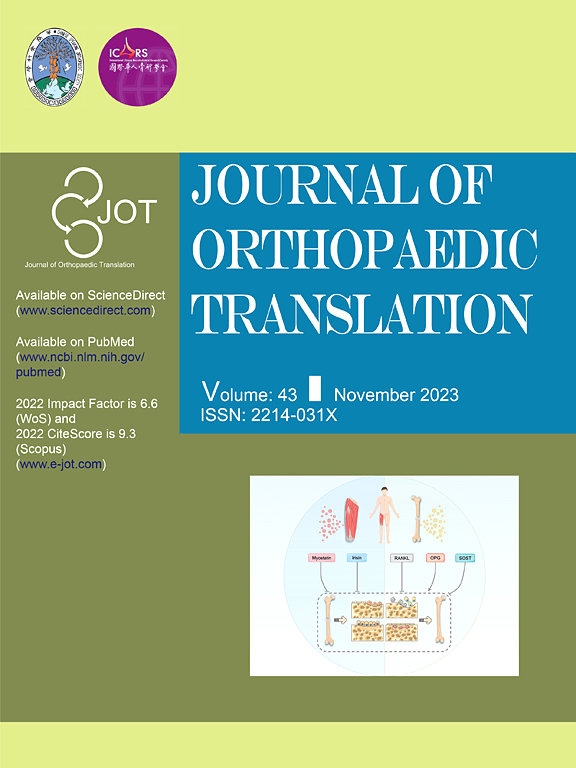Why muscle strengthening exercises should target the quadriceps and gluteus maximus in patients with knee osteoarthritis?: Effects of knee pain on muscle volume and fatty degeneration based on AI-assisted cross-sectional analysis
IF 5.9
1区 医学
Q1 ORTHOPEDICS
引用次数: 0
Abstract
Background
Sarcopenia, characterized by age-related muscle loss, traditionally presents as systemic muscle atrophy. However, knee osteoarthritis (OA) patients often exhibit localized quadriceps muscle atrophy, suggesting a potential pain-related mechanism distinct from classical sarcopenia. This study aimed to investigate the relationship between knee OA pain and selective muscle atrophy, particularly focusing on its role as a potential aggravating factor for sarcopenia.
Methods
Eighty-nine patients scheduled for unilateral primary total knee arthroplasty were analyzed. Preoperative computed tomography was used to compare muscle volume and intramuscular adipose tissue (IMAT) proportion between the more painful limb (Group 1) and the contralateral, less painful limb (Group 2). Analysis included both compartmental evaluation (anterior, medial, and posterior thigh compartments; hip abductors and external rotators) and individual muscle assessment.
Results
Group 1 demonstrated significant volume reduction in the anterior thigh compartment (specifically vastus lateralis, intermedius, and medialis) and gluteus maximus, compared to Group 2 (p < 0.05). IMAT proportion was significantly higher in most muscles of Group 1, except for hip abductors, tensor fascia latae, and gluteus minimus (p < 0.05), suggesting widespread fatty degeneration despite selective volume loss.
Conclusion
Knee osteoarthritis–related pain induces selective atrophy in the anterior thigh compartment and gluteus maximus while promoting diffuse fatty infiltration throughout the lower extremity. These findings suggest that OA-associated pain may exacerbate sarcopenia by driving both region-specific muscle loss and widespread intramuscular adipose degeneration.
The translational potential of this article
These findings underscore the importance of pain control as a primary therapeutic goal in patients with knee osteoarthritis. They also highlight the clinical necessity of targeted strengthening of the quadriceps and gluteus maximus muscles, given the role of knee pain in inducing secondary, selective muscle atrophy. Furthermore, symptoms commonly observed in elderly patients with OA—such as limping, giving way, lower extremity weakness, and patellofemoral knee pain—may not be attributable solely to the aging process. Rather, they may reflect secondary muscular adaptations driven by chronic pain during the progression of osteoarthritis (Figure 1).

为什么膝关节骨关节炎患者应该针对股四头肌和臀大肌进行肌肉强化训练?基于ai辅助横断面分析的膝关节疼痛对肌肉体积和脂肪变性的影响
背景:骨骼肌减少症以年龄相关的肌肉损失为特征,传统上表现为全身性肌肉萎缩。然而,膝关节骨性关节炎(OA)患者通常表现为局部股四头肌萎缩,提示与经典肌肉减少症不同的潜在疼痛相关机制。本研究旨在探讨膝关节OA疼痛与选择性肌肉萎缩之间的关系,特别关注其作为肌肉减少症潜在加重因素的作用。方法对89例单侧原发性全膝关节置换术患者进行分析。术前使用计算机断层扫描比较疼痛较重的肢体(1组)和对侧疼痛较轻的肢体(2组)的肌肉体积和肌内脂肪组织(IMAT)比例。分析包括两个室室评估(前、中、后股室);髋关节外展肌和外旋肌)和个体肌肉评估。结果与组2相比,组1显示大腿前腔室(特别是股外侧肌、中间肌和内侧肌)和臀大肌的体积明显减少(p <;0.05)。除髋外展肌、阔筋膜张肌和臀小肌外,组1大部分肌肉的IMAT比例均显著增高(p <;0.05),提示尽管选择性体积损失,但广泛存在脂肪变性。结论膝关节骨关节炎相关性疼痛可引起大腿前腔室和臀大肌选择性萎缩,同时促进弥漫性脂肪浸润至整个下肢。这些发现表明,oa相关的疼痛可能通过驱动区域特异性肌肉损失和广泛的肌内脂肪变性而加剧肌肉减少症。这些发现强调了疼痛控制作为膝骨关节炎患者主要治疗目标的重要性。他们还强调了临床上有针对性地加强股四头肌和臀大肌的必要性,考虑到膝关节疼痛在诱导继发性选择性肌肉萎缩中的作用。此外,在老年oa患者中常见的症状——如跛行、退行、下肢无力和髌骨膝关节疼痛——可能不仅仅是由于衰老过程。相反,它们可能反映了骨关节炎进展过程中由慢性疼痛驱动的继发性肌肉适应(图1)。
本文章由计算机程序翻译,如有差异,请以英文原文为准。
求助全文
约1分钟内获得全文
求助全文
来源期刊

Journal of Orthopaedic Translation
Medicine-Orthopedics and Sports Medicine
CiteScore
11.80
自引率
13.60%
发文量
91
审稿时长
29 days
期刊介绍:
The Journal of Orthopaedic Translation (JOT) is the official peer-reviewed, open access journal of the Chinese Speaking Orthopaedic Society (CSOS) and the International Chinese Musculoskeletal Research Society (ICMRS). It is published quarterly, in January, April, July and October, by Elsevier.
 求助内容:
求助内容: 应助结果提醒方式:
应助结果提醒方式:


